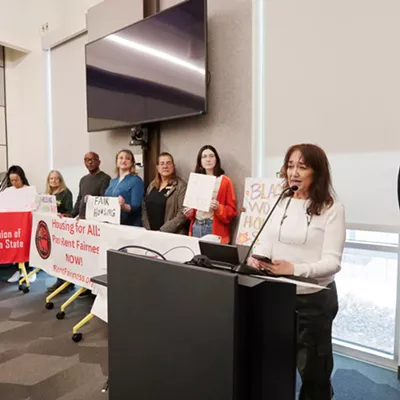A couple of hundred years ago, while the English king was distracted with diversions across the pond, the culture to the north in Scotland was rapidly changing. With the rise of industry, particularly textile mills, the Highlanders of the north migrated out of the hills and headed to the growing mill towns in the central and southern parts of the country. The Highlanders brought their Celtic-influenced culture with them to the burgeoning metropolitan areas, where they met up with the earthier Anglo-Saxon culture of the central and southern Lowlands. Out of this blending came a distinctly Scottish artistic tradition, led by poet Robert Burns, who helped breathe new life into Scottish music as well as literature.
That tradition continues to inspire musicians more than two centuries later. The Tannahill Weavers, who first gathered in Paisley, Scotland, more than three decades ago and will wind their way to The Met next Thursday, find their inspiration in that rich cultural tradition.
The group's name is an homage to their hometown's main industry, weaving, and its local poet laureate, Robert Tannahill, who looked to follow in Burns' footsteps. But they're not weighed down by any cultural baggage, guitarist and lead vocalist Roy Gullane explains, even though their music lives clearly in the traditional realm. "We try to put the cultural stuff out because people seem interested, " he says, "but we play it because we enjoy it. " And although the tunes are traditional -- or new tunes done in the traditional style -- the music has an up-to-date feel.
"Yes, the music is traditional, " says Gullane, one of the founding members of the group. "But it's played with a second-half-of-the-20th-century energy. "
Both energy and enjoyment are evident on the group's latest CD, Alchemy, released just last month on Green Linnet Records. It's so new that it may not be available yet in stores, but Gullane says the group will have copies available at the show. Marvelously danceable reels and jigs alternate with love songs both lively and melancholy. The vocal numbers are ably handled by Gullane and his mates, and many of the songs feature tight three- and four-part harmonies. The group employs the typical Celtic lineup of fiddle (John Martin), pipes (Duncan Nicholson) and flute (co-founder Phil Smillie), along with Gullane's guitar, but it also embraces Les Wilson's bouzouki for an unusual flair. (Although the bouzouki - a pear-shaped cousin to the lute - originated in the eastern Mediterranean region, it may not be entirely out of place in a Celtic band. Back around the 3rd or 4th century BC, the Celts had spread across much of Europe and into Galatia, part of modern-day Turkey.)
While Gullane carries most of the lead vocals and strong guitar work, the other members shine as multi-instrumentalists. Fiddler Martin switches over to the viola and cello on occasion, and Les Wilson sometimes trades his bouzouki for a place at the keyboards. Phil Smillie handles a variety of whistles and the bodhran (an Irish hand-held round frame drum) along with his flute, and piper Duncan Nicholson, the newest and youngest member of the group, takes on pipes and whistles large and small, all the way up to full Highland bagpipes. The members' versatility allows the group to perform a wide range of tunes, from strident marches and bouncy dances to tender ballads, with equal ease.
These are good times to be a Celtic musician. New radio shows dedicated to Celtic music are springing up across the country, and Celtic music has its own section in most record shops now. While their numbers don't approach the volume of pop or rock acts, Celtic musicians are making their presence felt. Some musicians with Celtic roots - Loreena McKennitt, Sarah MacLachlan, Sinead O'Connor and others - have crossed over into the world of pop, bringing Celtic sounds to even more listeners. In doing so, they've stretched the boundaries of Celtic music until it has blurred into another flavor of pop and moved far from its source. Has this new attention and prosperity caused any rifts among long-time Celtic performers?
"There have been discussions, " says Gullane with a sly chuckle, referring to differences between purists - those who argue that the traditional forms should not be modified in any way -- and musicians who incorporate newer influences in their work. "I can't understand the purists, " he continues. "The music began as a living tradition, and it should continue to be one. Sure, you have to keep it within certain parameters if you're going to be traditional, and the beauty of the melodies should remain. But it should be part of the present as well. We should try to go forward without losing the past. "
To that end, Gullane and the rest of the "Tannies " keep turning up new tunes to perform as well as creating new ones of their own. "We're always looking for new stuff, " Gullane says. "People are still composing and writing in the traditional style, so there are always new tunes. " Plus, they're always on the lookout for older tunes they haven't done before. After 27 years and 15 albums, they haven't run out of material yet. At the Spokane show, Gullane says they'll do a mix of tunes spanning the group's long history. "That's it exactly, " he says. "We like to do as much as possible from the earlier stuff and work in the new. "
Earlier this year, the group traveled through Germany, Italy and the UK for several weeks. Now, they're in the midst of a two-month tour of the States that will wrap up a few days after the show here in Spokane. After that, it'll be time for some hard-earned relaxation. "We'll be going home for quite a long spell, " Gullane says. "After this, our next thing is playing New Year's Eve at Stirling Castle. That's our second-biggest castle in Scotland, so it should be a lot of fun. "
During their time off, the group will start planning its next recording project. "That's kind of an ongoing project, " says Gullane, who also hopes to work on his second solo project. "Working solo gives me a chance to do something different, some slightly more contemporary songs, " he explains. "I get to do some dance tunes on my own. It gets my fingers really working. It's like a release, like therapy. "
& & & lt;i & The Tannahill Weavers play The Met on Thursday, Oct. 19 at 7:30 pm. Reserved tickets are $15, adults; $10, seniors and students. Call: 325-SEAT. & lt;/i & & lt;/center &
















